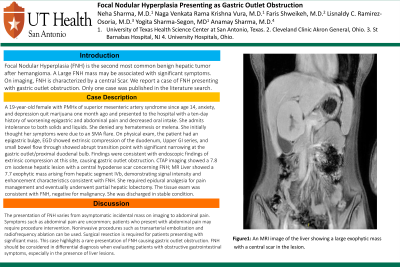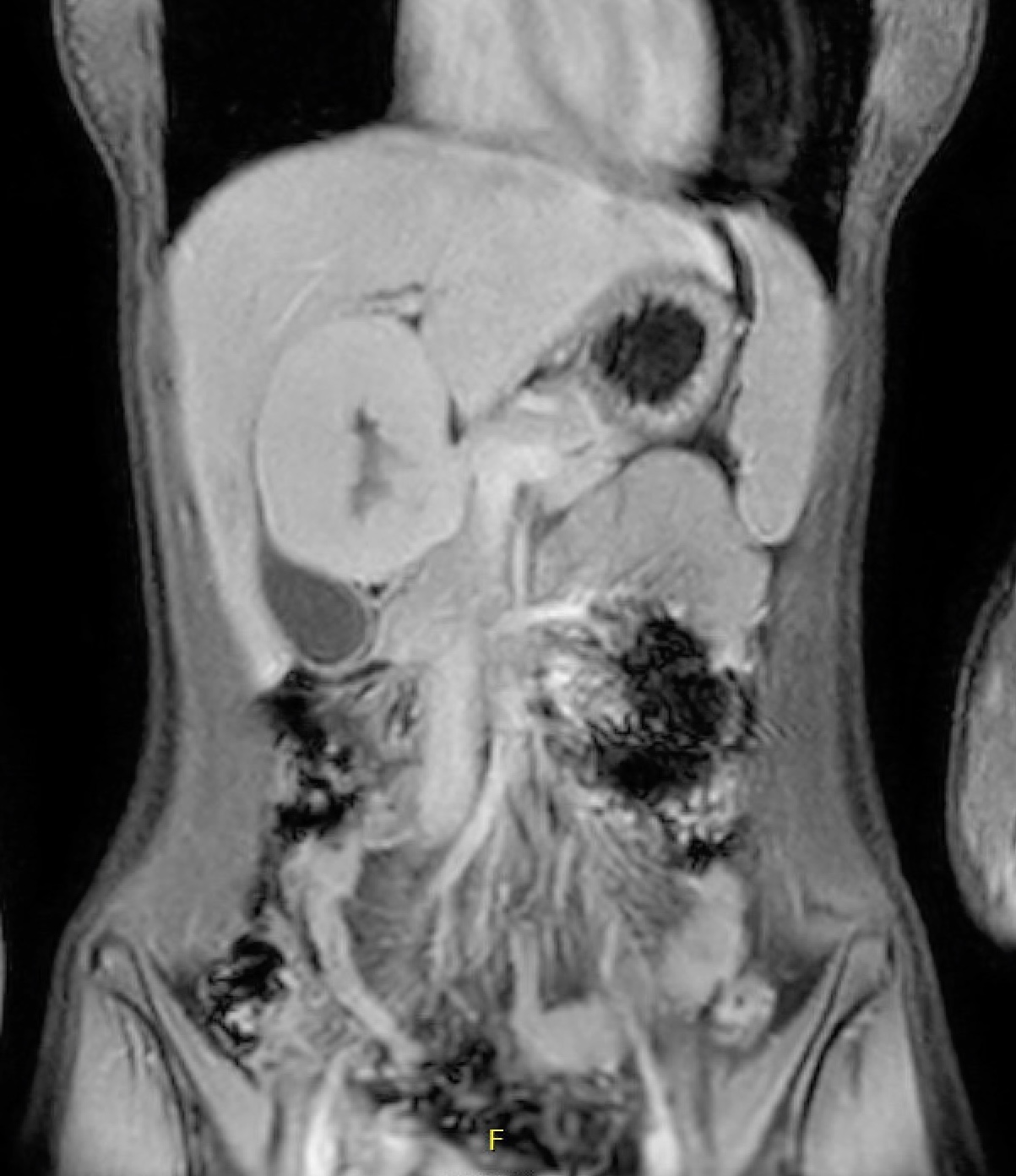Monday Poster Session
Category: Liver
P3107 - Focal Nodular Hyperplasia Presenting as Gastric Outlet Obstruction
Monday, October 28, 2024
10:30 AM - 4:00 PM ET
Location: Exhibit Hall E

Has Audio

Faris Shweikeh, MD
Cleveland Clinic Akron General
Akron, OH
Presenting Author(s)
Neha Sharma, MD1, Naga Venkata Rama Krishna Vura, MD2, Faris Shweikeh, MD3, Lisnaldy C. Ramirez-Osoria, MD4, Yogita Sharma-Segon, MD5, Anamay N. Sharma, MD6
1University of Texas Health Science Center, San Antonio, TX; 2University of Texas Health San Antonio, San Antonio, TX; 3Cleveland Clinic Akron General, Akron, OH; 4St. Barnabas Hospital, Bronx, NY; 5UT Health, San Antonio, TX; 6Case Western Reserve University School of Medicine, Cleveland, OH
Introduction: Focal Nodular Hyperplasia (FNH) is the second most common benign hepatic tumor after hemangioma. A Large FNH mass may be associated with significant symptoms. On imaging, FNH is characterized by a central Scar. We report a case of FNH presenting with gastric outlet obstruction. Only one case was published in the literature search.
Case Description/Methods: A 19-year-old female with PMHx of superior mesenteric artery syndrome since age 14, anxiety, and depression quit marijuana one month ago and presented to the hospital with a ten-day history of worsening epigastric and abdominal pain and decreased oral intake. She admits intolerance to both solids and liquids. She denied any hematemesis or melena. She initially thought her symptoms were due to an SMA flare. On physical exam, the patient had an epigastric bulge, EGD showed extrinsic compression of the duodenum, Upper GI series, and small bowel flow through showed abrupt transition point with significant narrowing at the gastric outlet/proximal duodenal bulb. Findings were consistent with endoscopic findings of extrinsic compression at this site, causing gastric outlet obstruction. CTAP imaging showed a 7.8 cm isodense hepatic lesion with a central hypodense scar concerning FNH; MR Liver showed a 7.7 exophytic mass arising from hepatic segment IVb, demonstrating signal intensity and enhancement characteristics consistent with FNH. She required epidural analgesia for pain management and eventually underwent partial hepatic lobectomy. The tissue exam was consistent with FNH, negative for malignancy. She was discharged in stable condition.
Discussion: The presentation of FNH varies from asymptomatic incidental mass on imaging to abdominal pain. Symptoms such as abdominal pain are uncommon; patients who present with abdominal pain may require procedure intervention. Noninvasive procedures such as transarterial embolization and radiofrequency ablation can be used. Surgical resection is required for patients presenting with significant mass. This case highlights a rare presentation of FNH causing gastric outlet obstruction. FNH should be considered in differential diagnosis when evaluating patients with obstructive gastrointestinal symptoms, especially in the presence of liver lesions.

Disclosures:
Neha Sharma, MD1, Naga Venkata Rama Krishna Vura, MD2, Faris Shweikeh, MD3, Lisnaldy C. Ramirez-Osoria, MD4, Yogita Sharma-Segon, MD5, Anamay N. Sharma, MD6. P3107 - Focal Nodular Hyperplasia Presenting as Gastric Outlet Obstruction, ACG 2024 Annual Scientific Meeting Abstracts. Philadelphia, PA: American College of Gastroenterology.
1University of Texas Health Science Center, San Antonio, TX; 2University of Texas Health San Antonio, San Antonio, TX; 3Cleveland Clinic Akron General, Akron, OH; 4St. Barnabas Hospital, Bronx, NY; 5UT Health, San Antonio, TX; 6Case Western Reserve University School of Medicine, Cleveland, OH
Introduction: Focal Nodular Hyperplasia (FNH) is the second most common benign hepatic tumor after hemangioma. A Large FNH mass may be associated with significant symptoms. On imaging, FNH is characterized by a central Scar. We report a case of FNH presenting with gastric outlet obstruction. Only one case was published in the literature search.
Case Description/Methods: A 19-year-old female with PMHx of superior mesenteric artery syndrome since age 14, anxiety, and depression quit marijuana one month ago and presented to the hospital with a ten-day history of worsening epigastric and abdominal pain and decreased oral intake. She admits intolerance to both solids and liquids. She denied any hematemesis or melena. She initially thought her symptoms were due to an SMA flare. On physical exam, the patient had an epigastric bulge, EGD showed extrinsic compression of the duodenum, Upper GI series, and small bowel flow through showed abrupt transition point with significant narrowing at the gastric outlet/proximal duodenal bulb. Findings were consistent with endoscopic findings of extrinsic compression at this site, causing gastric outlet obstruction. CTAP imaging showed a 7.8 cm isodense hepatic lesion with a central hypodense scar concerning FNH; MR Liver showed a 7.7 exophytic mass arising from hepatic segment IVb, demonstrating signal intensity and enhancement characteristics consistent with FNH. She required epidural analgesia for pain management and eventually underwent partial hepatic lobectomy. The tissue exam was consistent with FNH, negative for malignancy. She was discharged in stable condition.
Discussion: The presentation of FNH varies from asymptomatic incidental mass on imaging to abdominal pain. Symptoms such as abdominal pain are uncommon; patients who present with abdominal pain may require procedure intervention. Noninvasive procedures such as transarterial embolization and radiofrequency ablation can be used. Surgical resection is required for patients presenting with significant mass. This case highlights a rare presentation of FNH causing gastric outlet obstruction. FNH should be considered in differential diagnosis when evaluating patients with obstructive gastrointestinal symptoms, especially in the presence of liver lesions.

Figure: An MRI image of the liver showed a large exophytic mass with a central scar in the lesion.
Disclosures:
Neha Sharma indicated no relevant financial relationships.
Naga Venkata Rama Krishna Vura indicated no relevant financial relationships.
Faris Shweikeh indicated no relevant financial relationships.
Lisnaldy Ramirez-Osoria indicated no relevant financial relationships.
Yogita Sharma-Segon indicated no relevant financial relationships.
Anamay Sharma indicated no relevant financial relationships.
Neha Sharma, MD1, Naga Venkata Rama Krishna Vura, MD2, Faris Shweikeh, MD3, Lisnaldy C. Ramirez-Osoria, MD4, Yogita Sharma-Segon, MD5, Anamay N. Sharma, MD6. P3107 - Focal Nodular Hyperplasia Presenting as Gastric Outlet Obstruction, ACG 2024 Annual Scientific Meeting Abstracts. Philadelphia, PA: American College of Gastroenterology.
